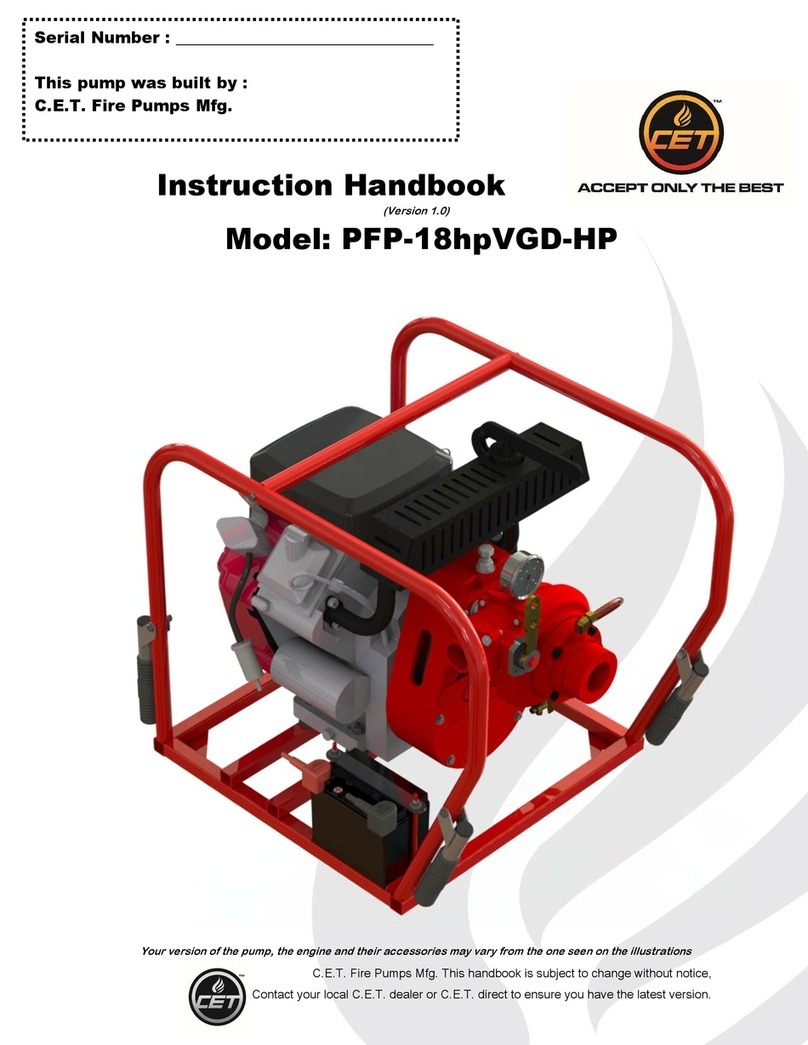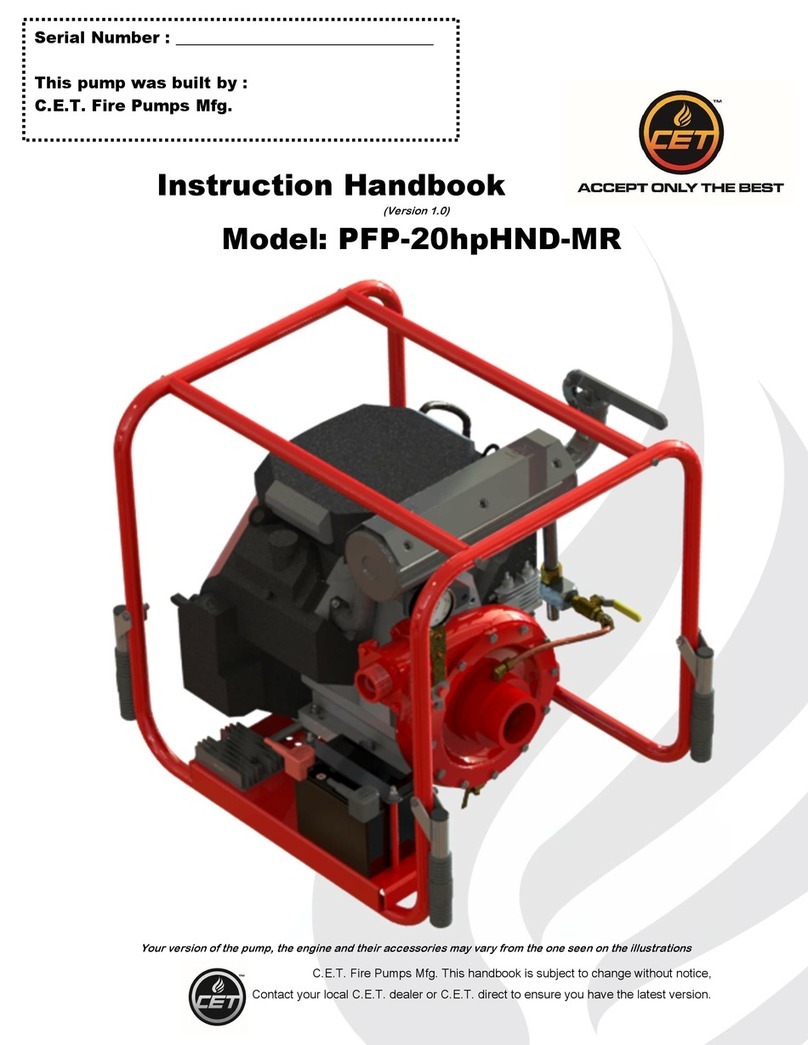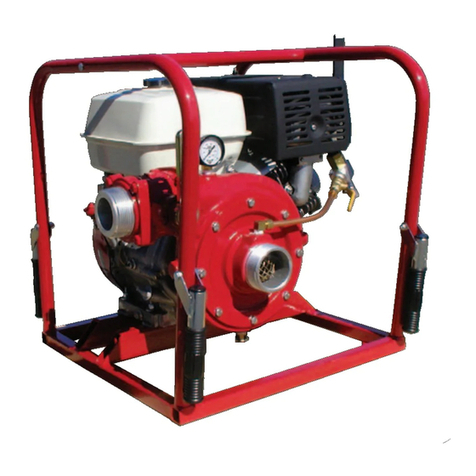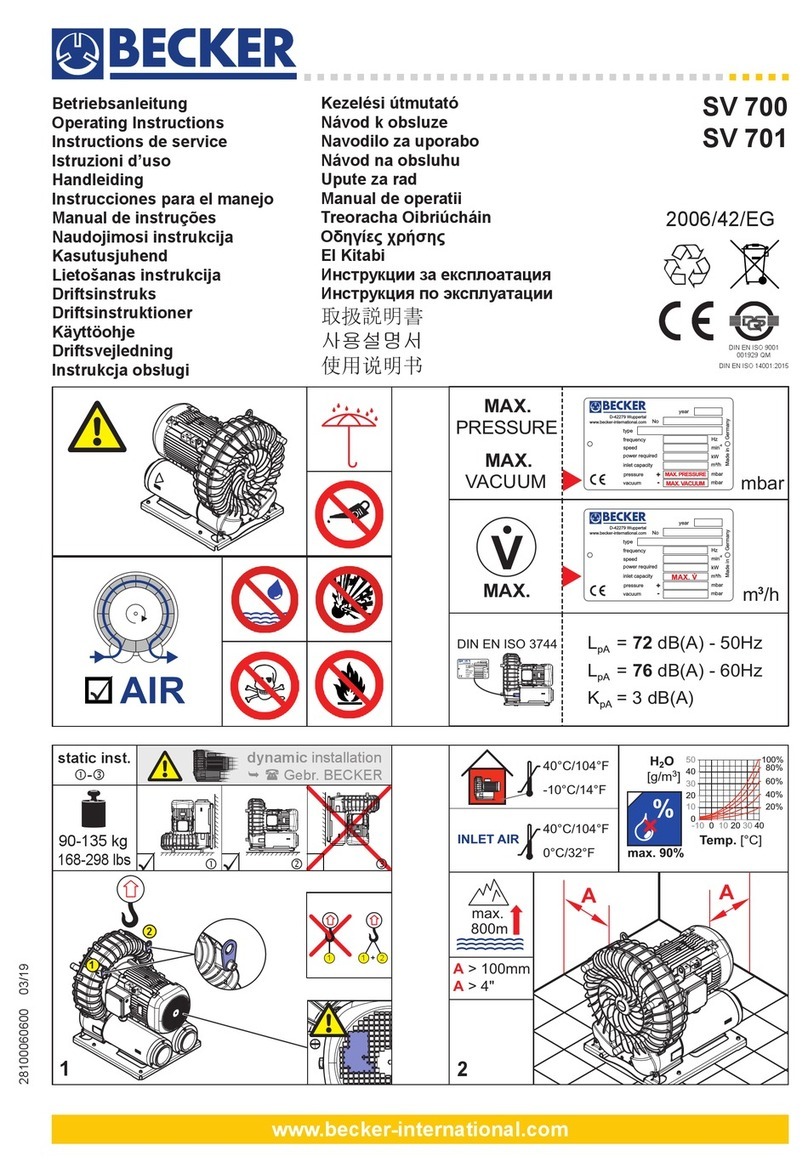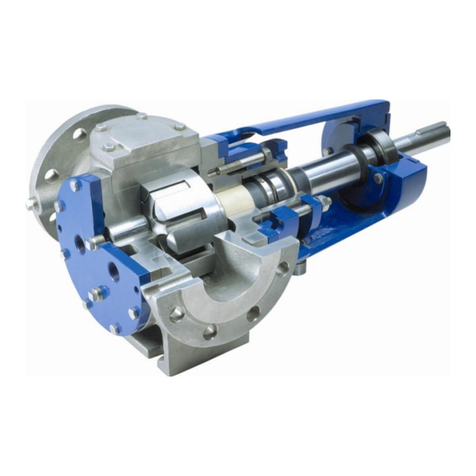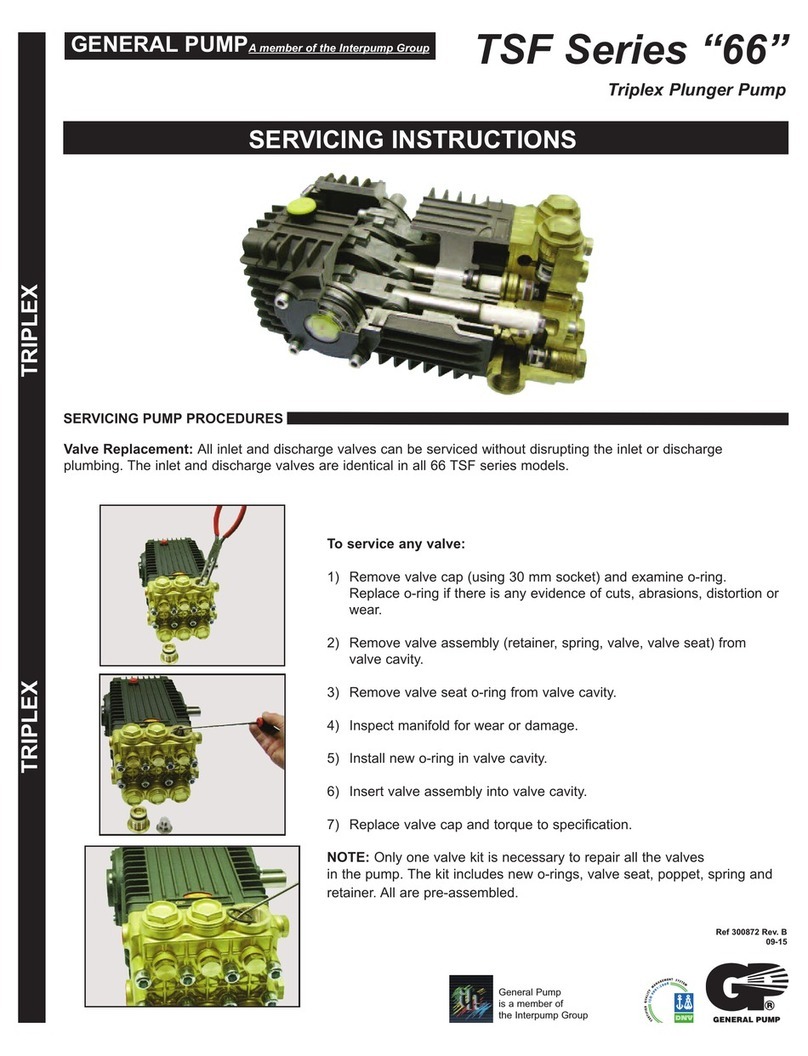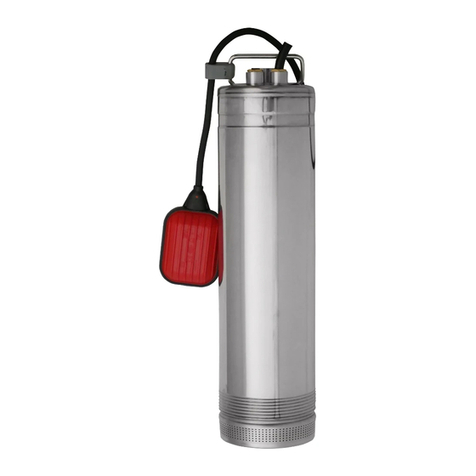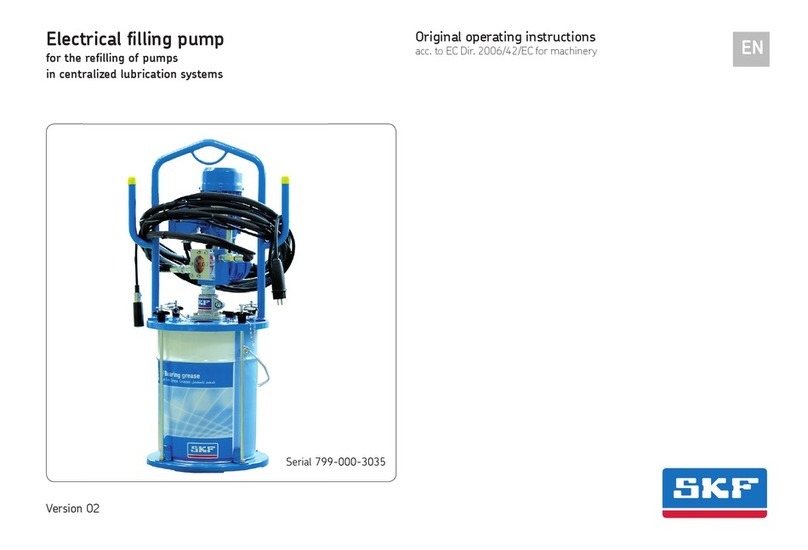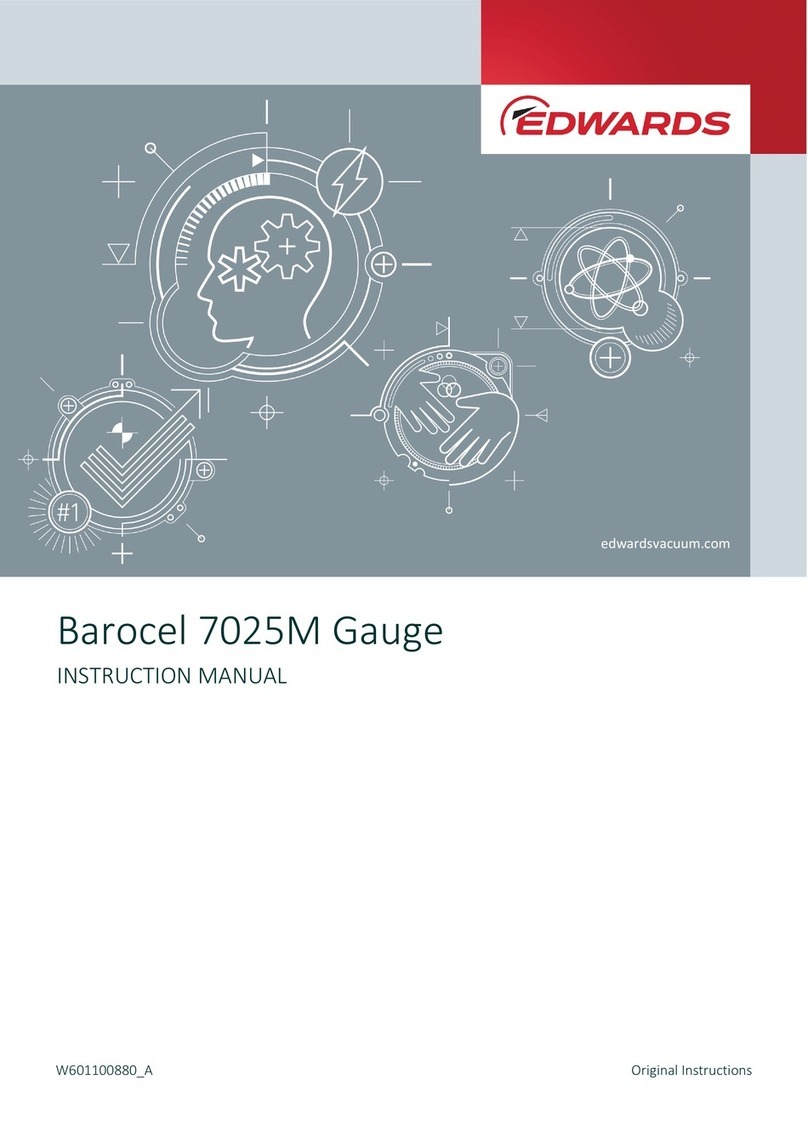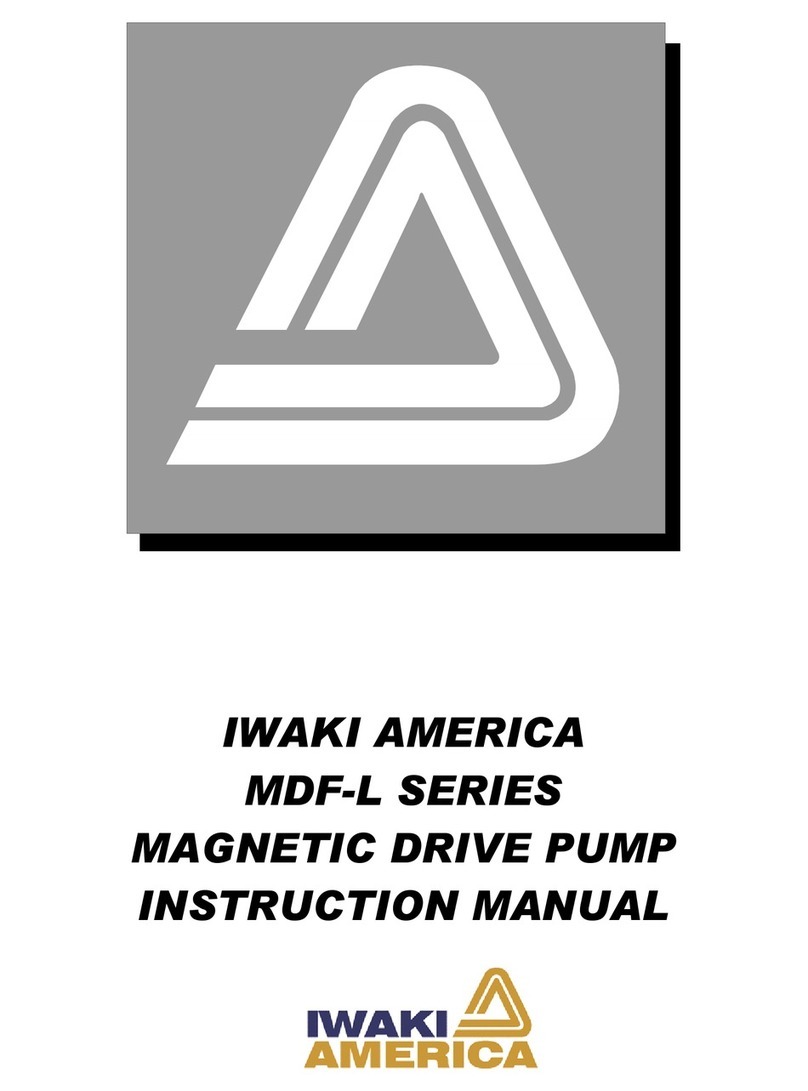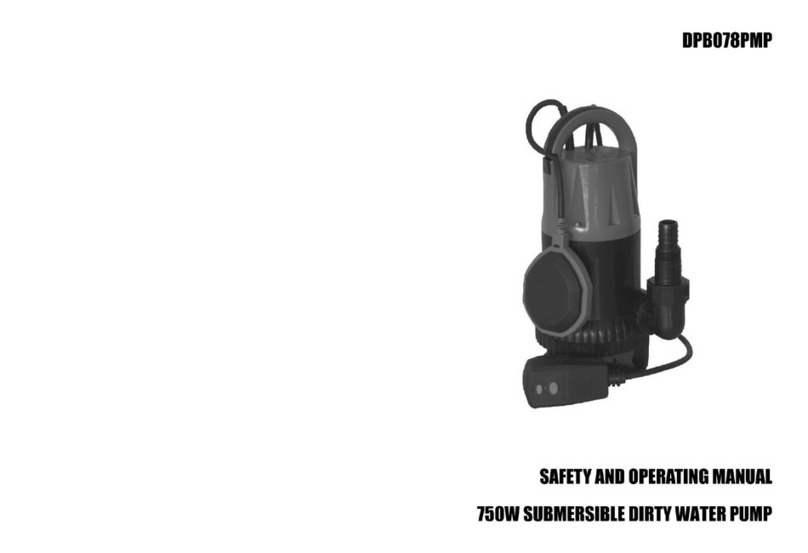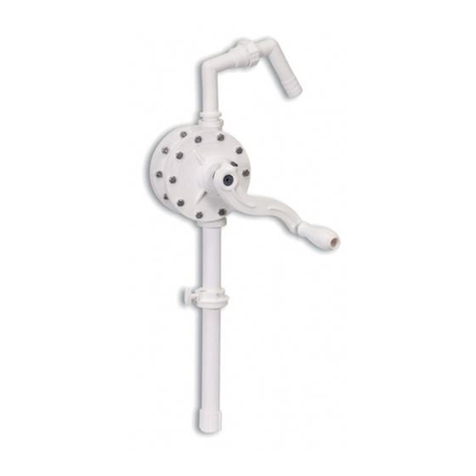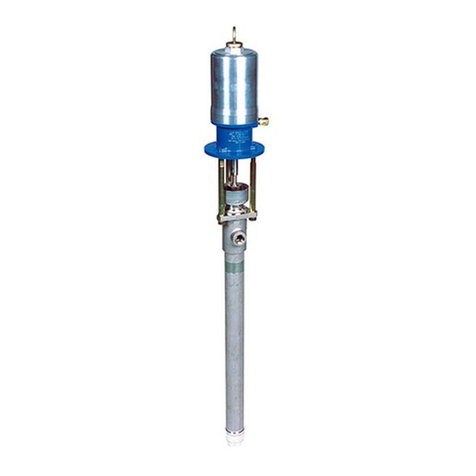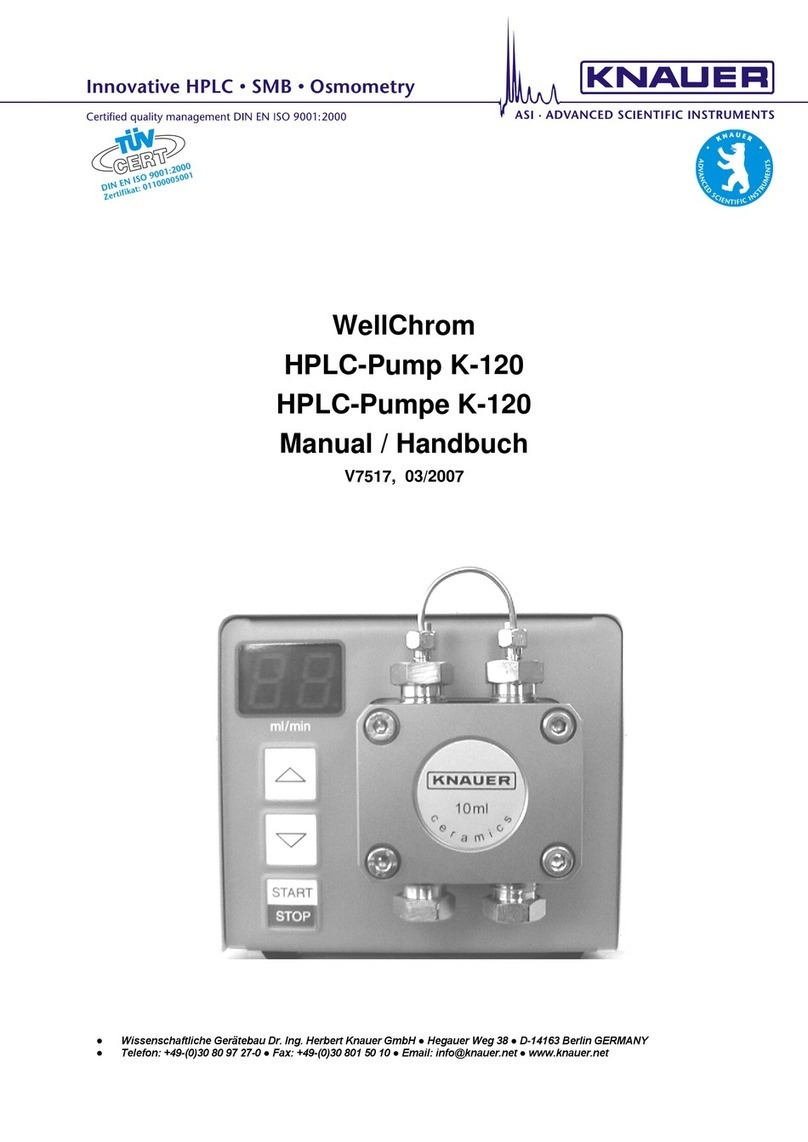CET PFP-20HPKHL-1D manual

C.E.T. Fire Pumps Mfg. This handbook is subject to change without notice,
Contact your local C.E.T. dealer or C.E.T. direct to ensure you have the latest version.
Instruction Handbook
(Version 1.0)
Model : PFP-20hpKHL-1D
Your version of the pump, the engine and their accessories may vary from the one seen on the illustrations
Serial umber : ________________________________
This pump was built by :
C.E.T. Fire Pumps Mfg.

Instruction Handbook PFP-20hpKHL-1D - 2 -
C.E.T. Fire Pumps Mfg. This handbook is subject to change without notice,
Contact your local C.E.T. dealer or C.E.T. direct to ensure you have the latest version.
Table of contents
1.
FOREWORD............................................................................................................................................... - 3 -
2.
SAFETY I STRUCTIO S.................................................................................................................... - 4 -
3.
DESCRIPTIO .......................................................................................................................................... - 7 -
4.
GE ERAL I STRUCTIO S.............................................................................................................. - 10 -
5.
TRA SPORT A D STORAGE ......................................................................................................... - 11 -
6.
PERFORMA CE .................................................................................................................................... - 12 -
7.
STARTI G PROCEDURE .................................................................................................................. - 13 -
8.
OPERATI G A D STOPPI G ......................................................................................................... - 17 -
.
STARTUP ................................................................................................................................................. - 18 -
10.
MAI TE A CE ................................................................................................................................ - 19 -
11.
TROUBLESHOOTI G GUIDE ..................................................................................................... - 20 -
12.
GE ERAL WARRA TY ................................................................................................................. - 22 -
13.
CO TACT US .................................................................................................................................... - 23 -

Instruction Handbook PFP-20hpKHL-1D - 3 -
C.E.T. Fire Pumps Mfg. This handbook is subject to change without notice,
Contact your local C.E.T. dealer or C.E.T. direct to ensure you have the latest version.
1.
Foreword
Congratulations on your purchase of a new C.E.T. portable pump, a quality
product based on a century of experience in building fire-fighting equipment. If
you follow the directives given in this handbook, your pump will be a useful ally
for many years to come.
For your own safety and those around you, it is important
that you read and understand each part of this handbook
BEFORE you start the pump. Always keep this manual
accessible so you can refer to it whenever the need
arrives.
All rights reserved. No part of this manual may be
reproduced without the prior written permission of C.E.T.
Fire Pumps MFG.

Instruction Handbook PFP-20hpKHL-1D - 4 -
C.E.T. Fire Pumps Mfg. This handbook is subject to change without notice,
Contact your local C.E.T. dealer or C.E.T. direct to ensure you have the latest version.
2.
Safety instructions
It is very important that you read and understand this handbook and the
owner’s manual of the engine before you start the pump.
oNEVER run the engine in an enclosed area. Exhaust gases contain carbon
monoxide which is an odorless and potentially deadly gas. You can run it if
using the exhaust hoses extensions.
oNEVER run the pump in a radius of 3 ft (1m) of a building or combustible
object.
oNEVER operate the engine if there is an accumulation of grass, leaves, or
other combustible material around, behind or under the muffler.
oNEVER run the engine without a muffler or proper exhaust system.
oNEVER operate the engine if the fuel tank cap is removed, do not fill the tank
while the engine is running. If fuel is spilled, move machine away from the
area of the spill and avoid creating any source of ignition until it has
completely evaporated.
oNEVER run the engine in an explosive environment.
oNEVER touch the spark plug or its components while running the engine; it
could give you an electric shock.
oNEVER put your foot or hand near moving parts.
oNEVER wear loose, bulky or torn clothing while operating the pump, it could
catch on moving parts and lead to serious injury.
oNEVER let your pump run unattended. It must always be operated by
trained personnel assuring the stability and direction of discharge hose.
oNEVER operate this machine while under the influence of drugs or alcohol.
oNEVER spray the pressurised flow of water at a person or animal.
DANGER

Instruction Handbook PFP-20hpKHL-1D - 5 -
C.E.T. Fire Pumps Mfg. This handbook is subject to change without notice,
Contact your local C.E.T. dealer or C.E.T. direct to ensure you have the latest version.
oNot following the instruction handbook directives and operating procedure
can lead to serious injuries, or even death. The operator and all other
members or personnel handling the hoses connected to the pump must be
trained and familiar with this type of product, know its limitations and have
read and understood the Instruction Handbook and engine manual.
oRisk of injuries resulting from pressure hazard.
Before you disconnect a hose or take off a cap on the inlet or outlet,
make sure the engine is stopped and open the drain valve to relieve
pressure.
NEVER touch a pressurized flow of water, it is abrasive and could lead
to serious injury.
oRisk of injuries resulting from very hot water, scald and burn hazards.
NEVER let the pump run for more than one minute with discharge
valve(s) completely closed. When the pump is running make sure to
always leave the discharge valve slightly opened, to avoid overheating
of the pump. If the pump runs completely closed with water flowing for
a few minutes, the water inside may heat-up and scald or burn the
operator when he opens the valve. The mechanical seal and other
components could also be damaged.
oRisk of injuries resulting from high temperature components, burn hazard.
NEVER touch the exhaust system, the muffler or the engine while it is
running. All these components get very hot and touching them may
cause burns.
oRisk of injuries resulting from kickback from the recoil starter.
To prevent injuries from kickback from the recoil starter, pull slowly on
the rope until you feel a resistance, then pull quickly.
oRisk of injuries resulting from tipping hazard.
NEVER operate the engine if the pump is not stable. Always chose a flat,
stable surface to operate the pump. The maximal slope for operation is
15°.
WARNING

Instruction Handbook PFP-20hpKHL-1D - 6 -
C.E.T. Fire Pumps Mfg. This handbook is subject to change without notice,
Contact your local C.E.T. dealer or C.E.T. direct to ensure you have the latest version.
oNEVER run the pump for more than one minute without water.
oNEVER run the engine without the proper amount of oil in the engine.
oNEVER alter the engine and/or the pump even partially.
Signs and Symbols
This warning symbol means that not following the attached note will put at
risk the security of the personnel operating near the pump. The words
“danger”, “warning” and “caution” are used for levels of risk.
This symbol means that it is mandatory to read and understand this handbook
as well as the operation manual from the engine manufacturer, BEFORE you
start the engine.
This symbol represents the risk of injury from high temperature surfaces.
This symbol represents the risk of intoxication from dangerous gases, such
as carbon monoxide.
This symbol represents the risk of injury caused by moving parts.
This symbol represents the hazards of handling dangerous material such as
gasoline or diesel.
CAUTION

Instruction Handbook PFP-20hpKHL-1D - 7 -
C.E.T. Fire Pumps Mfg. This handbook is subject to change without notice,
Contact your local C.E.T. dealer or C.E.T. direct to ensure you have the latest version.
3.
Description
This portable pump is directly driven by the very high-quality Kohler gasoline 20
hp engine. It is equipped with an electric starter and also has a backup recoil
starter. It has a detachable fuel tank of 6 gallons (22L). The pump has a 2.5”
(65mm) discharge and a 4” (100mm) inlet. It is equipped with an exhaust priming
system guaranteed up to 20’ (6m).

Instruction Handbook PFP-20hpKHL-1D - 8 -
C.E.T. Fire Pumps Mfg. This handbook is subject to change without notice,
Contact your local C.E.T. dealer or C.E.T. direct to ensure you have the latest version.
Dimensions:
Weight:
182 lbs (83kg)
The pump has a bronze impeller and a high resistance aluminum alloy body. It
also has an axial mechanical seal. The pump can operate to a maximum pressure
of 125 PSI (8.6bar). It has been designed to work at a temperature between 5°F (-
15°C) and 104°F (40°C). The manufacturer does not guarantee the performances
outside of this temperature range. The pump is operated with the throttle control
lever on the engine’s back. The pump should not run on a slope of more than 15°
of incline or be tilted at more than 35° when stopped.

Instruction Handbook PFP-20hpKHL-1D - 9 -
C.E.T. Fire Pumps Mfg. This handbook is subject to change without notice,
Contact your local C.E.T. dealer or C.E.T. direct to ensure you have the latest version.
The assembly includes
•High quality Kohler CH640 gasoline engine.
•Centrifugal pump with one (1) outlet.
•Exhaust priming system.
•Handling and protective frame.
•Throttle control system.
•One (1) sealed 12V battery.
•One (1) pressure gauge, displaying the outlet pressure of the pump.
The pump requires
•Oil (See the engine operator manual)
•Fuel (See the engine operator manual)
•A debris free source of water of at least 12’’ deep.
•A fully charged properly connected. (if the engine is equipped with an electrical
starter)
•Install in a properly ventilated area.
Recommended individual protective equipments (not included)
•Firefighting grade protective gloves (conforms to EN65 or equivalent).
•Protective glasses.
•Hearing protection
Intended use for application
This pump has been designed to move water for fire-fighting purposes. It has been
engineered to run under the constant supervision of an operator properly trained.
The pump was assembled according to the intended use of the engine
manufacturer. Any use that doesn’t conform with the previously stated intended
use is not authorized unless C.E.T. Fire Pumps Mfg. gives such authorization in
writing. A violation of this agreement could compromise the safety of the
personnel working near the pump. The manufacturer’s responsibility would be
voided by C.E. Thibault Ladders Inc. and/or C.E.T. Fire Pumps Mfg. for damages
resulting from unauthorized use.

Instruction Handbook PFP-20hpKHL-1D - 10 -
C.E.T. Fire Pumps Mfg. This handbook is subject to change without notice,
Contact your local C.E.T. dealer or C.E.T. direct to ensure you have the latest version.
4.
General instructions
This pump must only be operated by trained personnel.
WARNING: The hydraulic power of the pump discharge can cause
severe damage, even death. Never, upper any circumstance, point the
discharge hose toward a person or an animal, handle with care.
Highly contaminated water containing sand or rocks of diameters larger than
0.200” (5mm) could damage and shorten the lifespan of your pump. Always use a
strainer at the end of the suction hose. If you are not sure of the quality of the
pumped water, use a floating strainer to prevent drawing the sand or stone from
bottom source.
The Kohler CH640 engine runs on gasoline fuel (Octane rating of 87 (R+M)/2 or
higher, research octane Number (RON) 0 octane minimum, Gasoline up to 10%
ethyl alcohol, 0% unleaded is acceptable, Methyl tertiary Butyl Ether (MTBE) and
unleaded gasoline blend (max 15% MTBE by volume) are approved) and requires
a quantity of 2 qt (1. L) of oil (10W-30/SAE 30 / 5W-30) for a running temperature
range of -20°F (-28°C) to 100°F (37°C). (Refer to the engine manual)
WARNING: Always stop the engine before refilling the fuel tank.
WARNING: The exhaust system will get very hot. If the engine
manufacturer recommendations are not followed it could also emit
sparks, which could set the nearby environment on fire
CAUTION: Read and understand the engine owner’s manual and this
instruction handbook before you start the engine.

Instruction Handbook PFP-20hpKHL-1D - 11 -
C.E.T. Fire Pumps Mfg. This handbook is subject to change without notice,
Contact your local C.E.T. dealer or C.E.T. direct to ensure you have the latest version.
5.
Transport and storage
Transport :
WARNING: Never transport the pump while it is running.
The pump and its frame have been designed to be easily transported by two adults
or more.
The pump shouldn’t be inclined by more than 35° during transport, especially if
the engine has oil in it.
Storage:
Warning: It is important to take into account the dangerous materials and
components, such as diesel, oil and the battery. Store away from heat
source, flames and sparks (e.g. heater using a pilot).
The pump should be stored in a cool, dry place away from salty air at the exception
if the pump has the marinization treatment. If the pump is to be stored for over 30
days, you should completely drain the fuel and carefully follow the steps written
in your engine owner’s manual. It is important to disconnect the battery and
charge it at least once every 3 months if you don’t use the pump for that period of
time.

Instruction Handbook PFP-20hpKHL-1D - 12 -
C.E.T. Fire Pumps Mfg. This handbook is subject to change without notice,
Contact your local C.E.T. dealer or C.E.T. direct to ensure you have the latest version.
6.
Performance
The pump running under *normal conditions will give you these performances:
*
Normal conditions : geostatic height of 4’ 10” (1.5m), temperature de 5 °F (15°C), water clear of sand
and debris, atmospheric pressure < 3280’ (1000m) from sea level
None conformance to the instructions given in this handbook can reduce the
performances given by the pump.
0
500
1000
1500
2000
012345678910
0
100
200
300
400
500
600
0 25 50 75 100 125 150
Flow (LPM)
Head (BAR)
Flow (GPM)
Head (PSI)
Flow (GPM / LPM) Pressure (PSI / Bar)
485 / 1836 10 / 0.6
430 / 1627 25 / 1.7
350 / 1324 50 / 3.4
140
/
530
100
/
6.
6
5
/
246
125
/
8.6

Instruction Handbook PFP-20hpKHL-1D - 13 -
C.E.T. Fire Pumps Mfg. This handbook is subject to change without notice,
Contact your local C.E.T. dealer or C.E.T. direct to ensure you have the latest version.
7.
Starting procedure
7.1. Place the pump on a flat and stable surface with an angle less than
15°. Place your pump as close as possible to the water source.
WARNING: NEVER run the engine in an enclosed area. Exhaust
gas contains carbon monoxide, an odorless and potentially
deadly gas.
7.2. Check the oil level.
7.3. Check the fuel level.

Instruction Handbook PFP-20hpKHL-1D - 14 -
C.E.T. Fire Pumps Mfg. This handbook is subject to change without notice,
Contact your local C.E.T. dealer or C.E.T. direct to ensure you have the latest version.
7.4. Connect the suction hose and the discharge hose. Make sure that
there is a rubber seal on the adapter and screw it tight. Verify the water
source to be used is clear of sand and/or small rocks, if you have any doubt
about your water source, we recommend you use a floating strainer. If
sand enters your pump it would damage the seal and wear rings, reducing
useful life. The water source should be at least 12” deep.
WARNING: The discharge hose will tend to straighten up when filled with
water. Make sure it won’t compromise the safety of your installation. Warn
the surrounding people before you start the pump. It is important that you
evaluate the trajectory of the hose to prevent incidents.
NOTE: If you are pumping from a hydrant, replace step 7.7 by: “open the valve or
any other control mechanism of the hydrant to fill your pump”. Follow the rest of
the procedure but skipping section 7. to 7.13. We recommend you avoid having
an inlet pressure over 75 PSI, it will accelerate wear of the mechanical seal.
7.5. Put the control throttle in starting position.
7.6. Close the drain valve and the discharge valve, make sure the pump is
sealed from any air leakage.
7.7. Open the priming valve.
WARNING: Always make sure a trained person firmly holds the extremity of
the discharge hose before starting the engine. The hydraulic power of the
pump could cause the hose and nozzle to move violently and cause material
damage, severe injuries or even death.

Instruction Handbook PFP-20hpKHL-1D - 15 -
C.E.T. Fire Pumps Mfg. This handbook is subject to change without notice,
Contact your local C.E.T. dealer or C.E.T. direct to ensure you have the latest version.
7.8. *Start the engine with the electric start or by pulling on the recoil
starter handle.
*Check the engine owner’s manual for the starting and stopping
procedure.
WARNING: Make sure you know the stopping procedure of the engine
before starting it.
7. . Close the exhaust port.
7.10. Speed up the engine with the throttle control to its maximum speed.
CAUTION: NEVER run the pump dry for more than one (1) minute, it could damage
the mechanical seal. Always prime the pump as fast as possible.
7.11. When water comes out of the venturi (it should take approximately 15
to 30 seconds when priming from 10’ x 4" suction hose), open slowly the
discharge valve.
7.12. When water comes out of the pump, close the priming valve
7.13. Open the exhaust port.
CAUTION: NEVER run the pump with the exhaust port closed once the priming is
completed. As soon as the pump is running by it-self it is important to open the
exhaust port.
7.14. You can adjust the ratio flow/pressure by two means.
7.14.1. Adjust the throttle of the engine to desired pressure.

Instruction Handbook PFP-20hpKHL-1D - 16 -
C.E.T. Fire Pumps Mfg. This handbook is subject to change without notice,
Contact your local C.E.T. dealer or C.E.T. direct to ensure you have the latest version.
7.14.2. Control the opening of a valve or a nozzle at the end of the
discharge hose. By reducing the opening, pressure will increase and
flow will decrease.
WARNING: NEVER run the pump at high speed with the discharge valve closed
more than one (1) minute. The water could heat up. Upon opening the valve, the
operator could be burned.

Instruction Handbook PFP-20hpKHL-1D - 17 -
C.E.T. Fire Pumps Mfg. This handbook is subject to change without notice,
Contact your local C.E.T. dealer or C.E.T. direct to ensure you have the latest version.
8.
Operating and stopping
Adjust the throttle lever or the opening of the nozzle at the end of the discharge
hose accordingly to the desired flow/pressure rate.
To stop the engine, slow down its RPM to idle and turn the key position to « OFF ».
Open the drain valve under the body of the pump and let it drain completely.
CAUTION: NEVER leave water inside the casing of the pump and valves. The
water could freeze and damage them.
CAUTION: After each use, it is important to flush the inside of your pump with
fresh water. This will help prevent damages and wear to the pump components.
IF the pump has been used to pump salt water:
•Drain the salt water completely.
•Flush the pump with fresh water to prevent corrosion and salt crystals from
forming.
•Apply a spray silicone compound to the pump internal components.
•Replace hose connection caps. (If your pump is equipped with them).
WARNING: NEVER let the pump run unsupervised. Stop the engine before
transporting the pump or filling the fuel tank. The engine and its components
will be very hot when and after running. Let it cool down before touching it.

Instruction Handbook PFP-20hpKHL-1D - 18 -
C.E.T. Fire Pumps Mfg. This handbook is subject to change without notice,
Contact your local C.E.T. dealer or C.E.T. direct to ensure you have the latest version.
.
Startup
Get the pump ready for start-up:
Remove from packing. Check the oil level of the engine and the level of fuel. Make
sure the electrical connections have not been damaged or disconnected during
transport. Make sure that no bolt or screw has been loosened by vibration in
transport. Every pump that we build is tested at the factory and meets rigorous
standards of quality. To make sure that nothing outside our control occurred
between our test and the delivery of your pump, we recommend you do a
functional test
Functional test:
Connect suction hose of 4’’ diameter and a length of 10’. Make sure to completely
submerge the end of the suction hose at least 12’’. Connect a discharge hose of
2.5’’ diameter and not more than 30’. The difference of height between the inlet of
the pump and the surface of the water source should not be over 6’. The pump
test should be done at an altitude lower than 3280’ (1000m) from sea level.
Not matching these conditions could reduce the performance of the pump.
Initiate starting procedure:
Be certain not to prime more than 30 seconds. Confirm the pump performances
correspond to the chart given in this manual (see section 6. Performance), with a
maximum variation of 15%. If your test doesn’t match these results, make sure
you have the same conditions as described here and that you have correctly
followed the starting procedure. Otherwise contact your local C.E.T. Fire pumps
dealer or C.E.T. direct.

Instruction Handbook PFP-20hpKHL-1D - 19 -
C.E.T. Fire Pumps Mfg. This handbook is subject to change without notice,
Contact your local C.E.T. dealer or C.E.T. direct to ensure you have the latest version.
10.
Maintenance
This periodic maintenance table is not enough for a complete servicing of the
engine. You must refer to the owner’s manual to make sure to apply a complete
maintenance of the engine. It is highly recommended that you keep a record of
the number of running hours of your pump and all the maintenance operations
applied on it. If you require spare parts or a more detailed maintenance
procedures, please contact your local C.E.T. Fire pumps dealer or C.E.T. direct.
Dispose properly of the used oil and filters according to the local
environmental regulations.
WARNING: Never run the pump if the inlet strainer is not on or is damaged.
Maintenance
Interval
Daily First 8
hours
Every 50
hours
Every 100
hours
Check oil level and add some if required
Check for oil or fuel leakage
Make sure the throttle control, the discharge valve, the drain valve
and the priming valve are working well.
Check and clean the air intake, also make sure the recoil starter rope
is undamaged.
Check the protective frame for damage.
Clean the pump inlet strainer and make sure it is not obstructed.
Check the seals for any leakage, change them if required.
Make sure the electric components are properly connected and safe
Change the engine oil annually, even if the number of running hours is less than recommended.
Recharge the battery at least every three(3) months

Instruction Handbook PFP-20hpKHL-1D - 20 -
C.E.T. Fire Pumps Mfg. This handbook is subject to change without notice,
Contact your local C.E.T. dealer or C.E.T. direct to ensure you have the latest version.
11.
Troubleshooting guide
For all problems that are not covered by this table, please contact your local C.E.T. Fire pumps dealer or C.E.T. direct.
Problem
Probable cause
Remedy
The engine won't start
No fuel in the combustion
chamber The fuel tank is empty Fill the fuel tank
The electric starter doesn't
work Not enough electrical power Check the electrical connections, check if the battery is charged, if required charge the battery. Check the engine
manual for faulty electrical starter problems. Use the recoil starter.
Faulty engine Refer to the troubleshooting guide of the engine owner's manual
The engine output is
low
Engine is overheating Refer to the troubleshooting guide of the engine owner's manual
The engine won't speed up The throttle control system is
malfunctioning Reset, repair or change the throttle control system.
The engine seems to
speed up and down
Air pockets are created in the
suction hose
Air pockets in the suction hose Make sure the inlet hose is straight and doesn't have a sharp turn angle allowing the formation of an air pocket.
Suction hose is not air tight Make sure to have well understood and applied the priming protocol of the pump. Check for any possible air leakage
in the suction hose. Check the mechanical seal for leakage.
Faulty engine Refer to the troubleshooting guide of the engine owner's manual
The engine works but
the priming system
doesn't seems to be
able to fill the pump.
(part 1/2)
The exhaust gas flow going
through the venturi isn't high
enough
The engine speed is too low The throttle should be in the "fast" position while priming. For engine's speed problem, refer to "the engine output is
low" section.
The exhaust port isn't
completely closed.
Check if the exhaust port closing handle completely covers the outlet pipe. Clean up and flatten the closing surface
beneath the exhaust port closing handle.
The pump is not air tight
The primer sucks in ambient air
and thus can't take out all the
air from the suction pipe
Make sure drain valve and discharge valve are closed. Verify the suction hose(s) and the gaskets are in good
conditions.
Verify the end of the suction hose is completely submerged by at least 12" (305mm) of water. When pumping high
volumes of water, sometimes a whirlpool is created by the suction. If so, make sure to submerge the suction hose
end by at least 24" (610mm).
The pump is too high above
the water source
The height of water to pull up is
above the priming system
capacity
The priming system is guaranteed up to 20' (6meters). Above this height it is highly suggested to reduce the height
difference.
Table of contents
Other CET Water Pump manuals
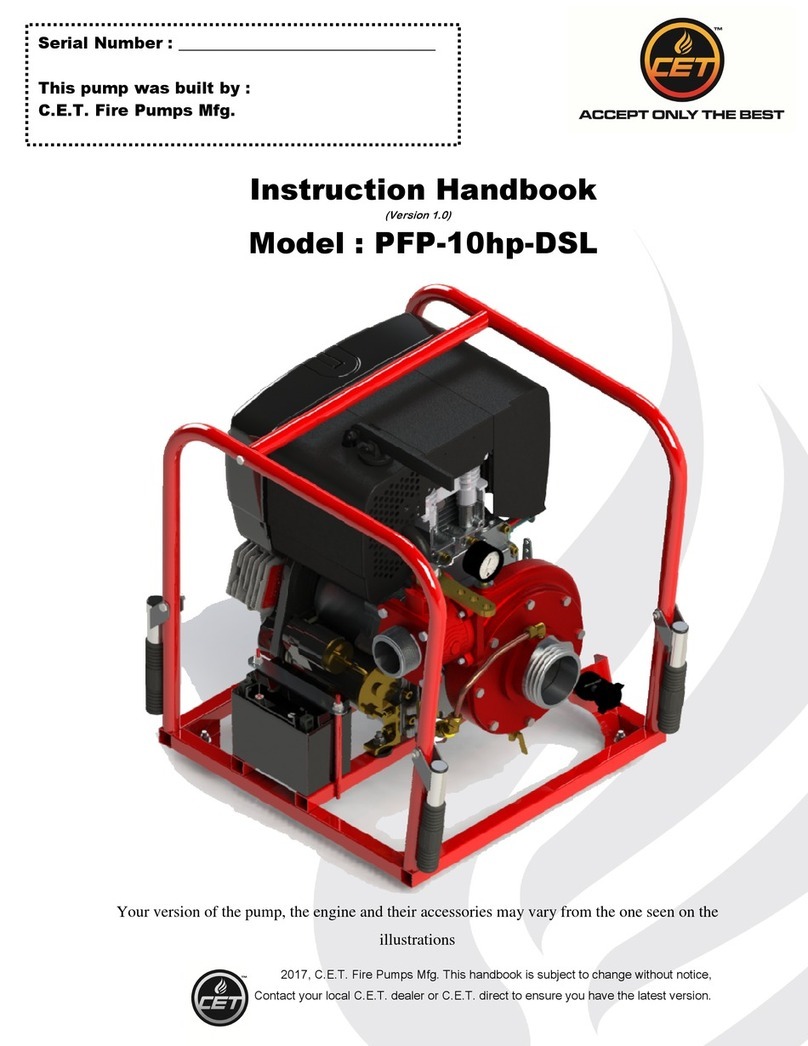
CET
CET PFP-10hp-DSL manual
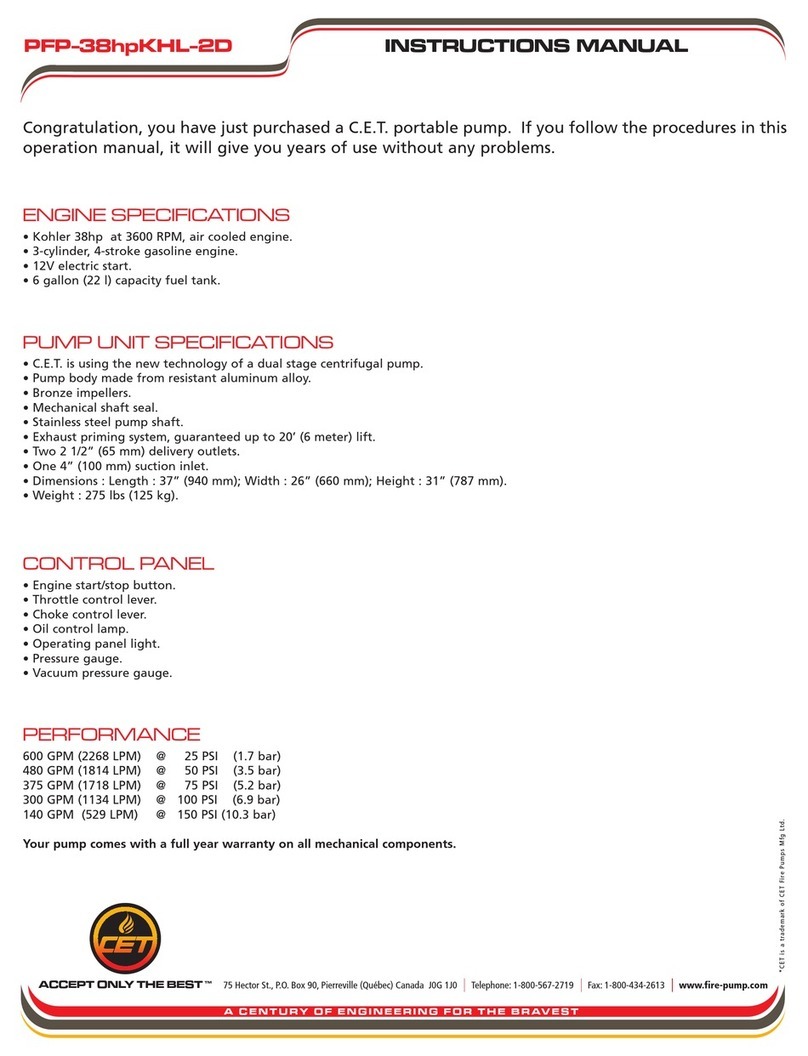
CET
CET PFP-38hpKHL-2D User manual
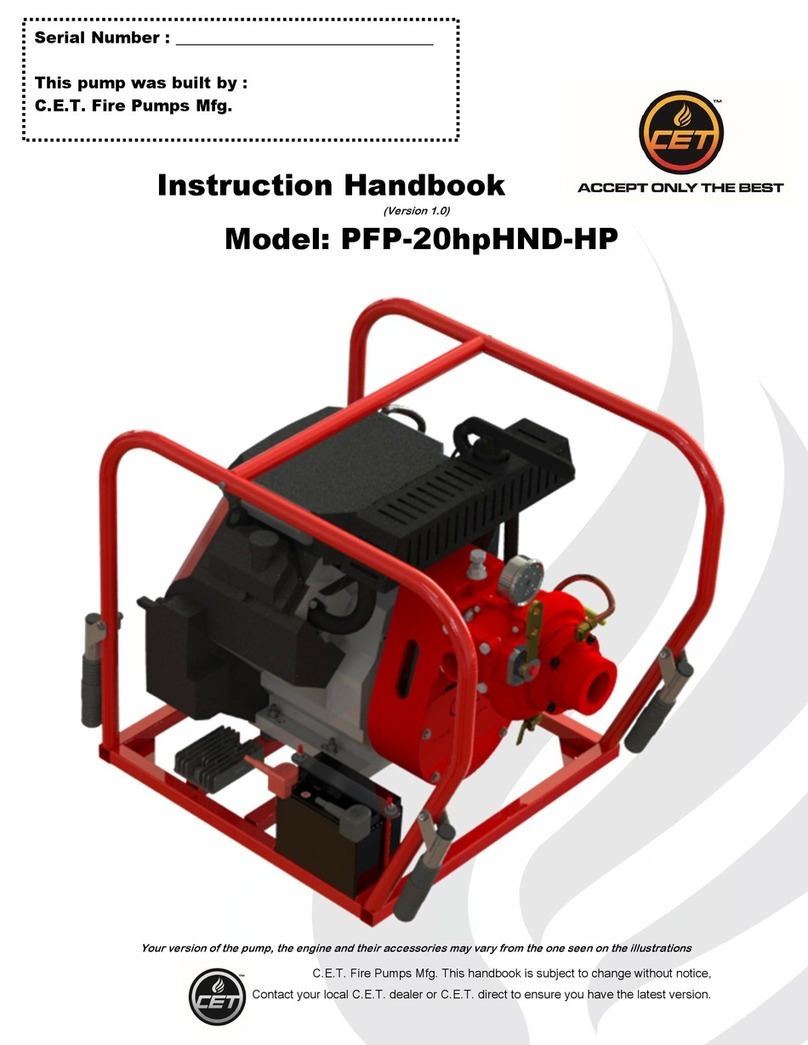
CET
CET PFP-20hpHND-HP manual
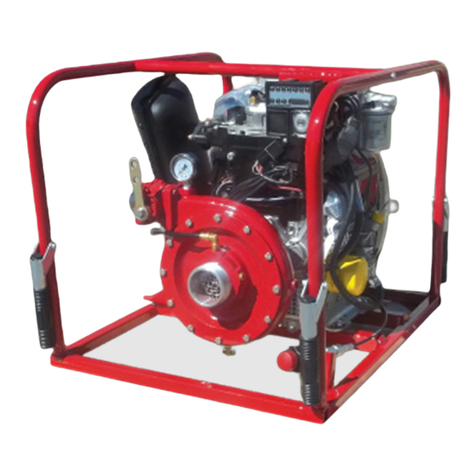
CET
CET PFP-19hp-DSL-AFL User manual
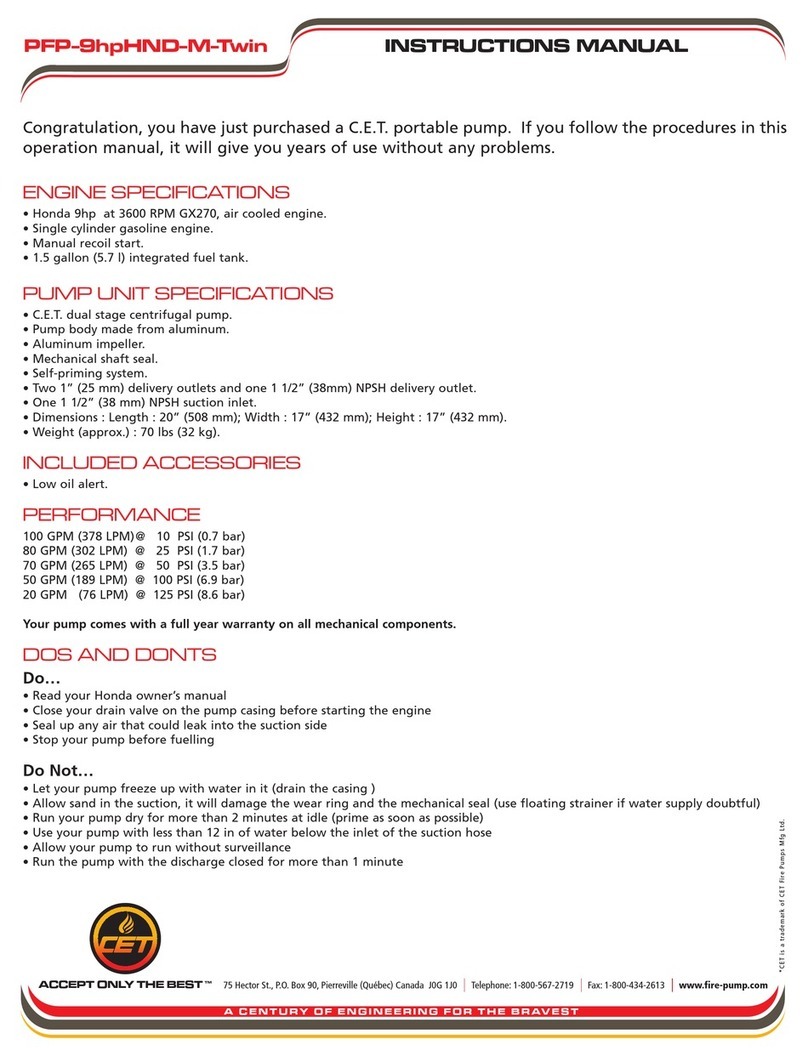
CET
CET PFP-9hpHND-M-Twin User manual
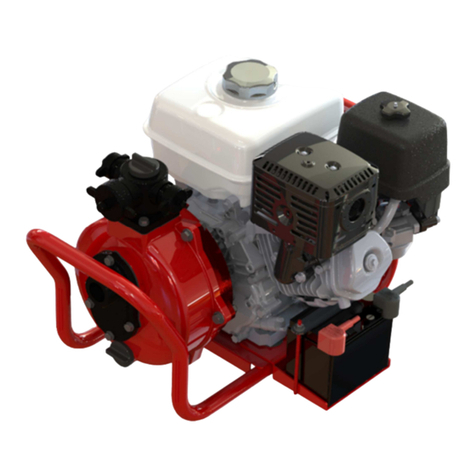
CET
CET PFP-9hpHND-EM-Twin User manual
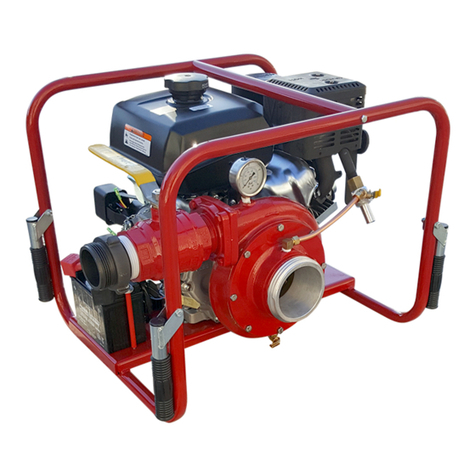
CET
CET PFP-14hpKHL-EM-MR manual

CET
CET PFP-20HP-HND-1D User manual
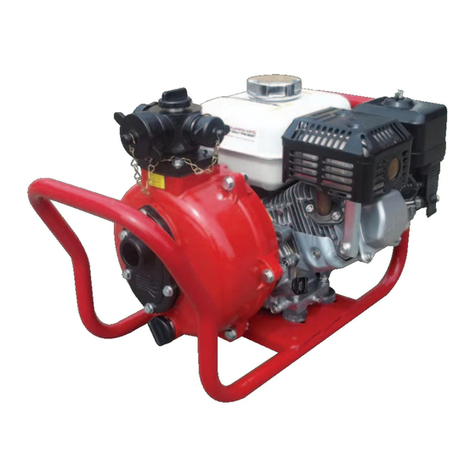
CET
CET PFP-6HPHND-M-TWIN manual

CET
CET PFP-11hpHND-M-HP User manual

CET
CET PFP-9hpHND-EM-Twin manual

CET
CET PFP-38hpKHL-2D manual
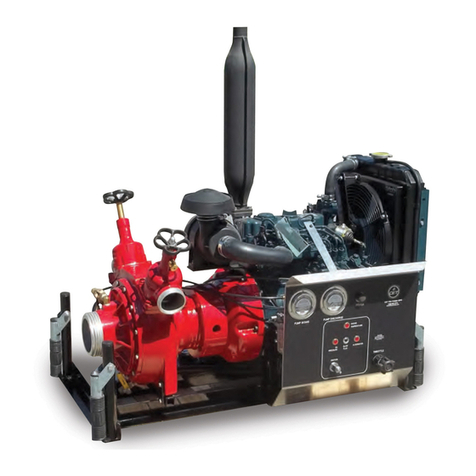
CET
CET SM-PFP-25hp-DSL-MR User manual

CET
CET PFP-23HPVGD-HP manual
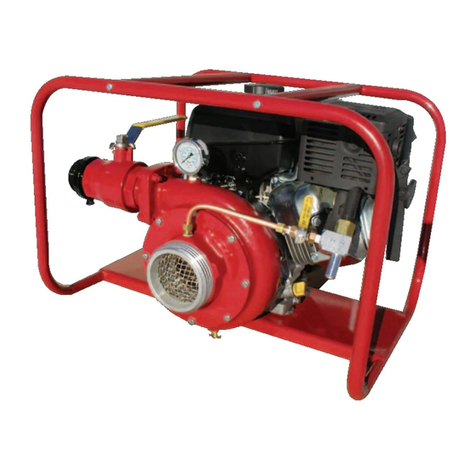
CET
CET PFP-14hpKHL-1D User manual
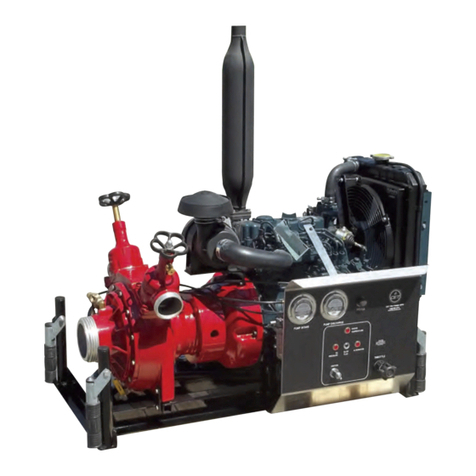
CET
CET PFP-25hp-DSL User manual
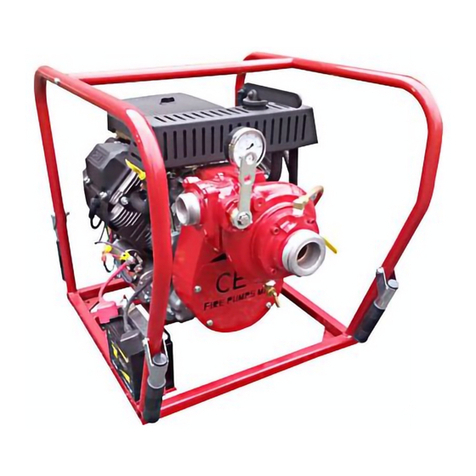
CET
CET PFP-20hp-KHL-HP User manual

CET
CET PFP-20HPHND-2D User manual
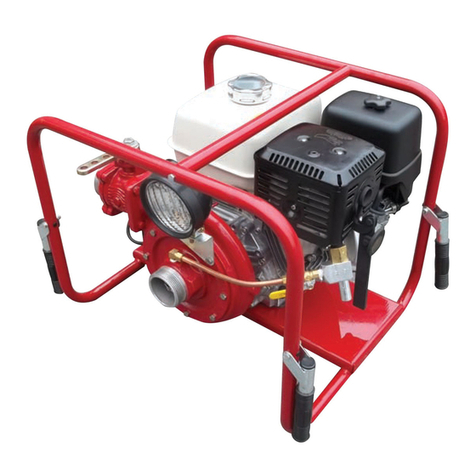
CET
CET PFP-11hpHND-M manual
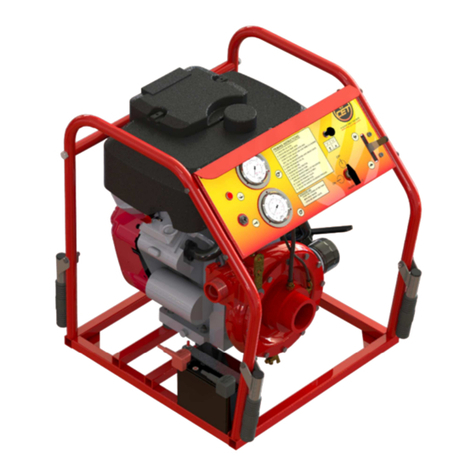
CET
CET PFP-18HPVGD-MR-CE manual
